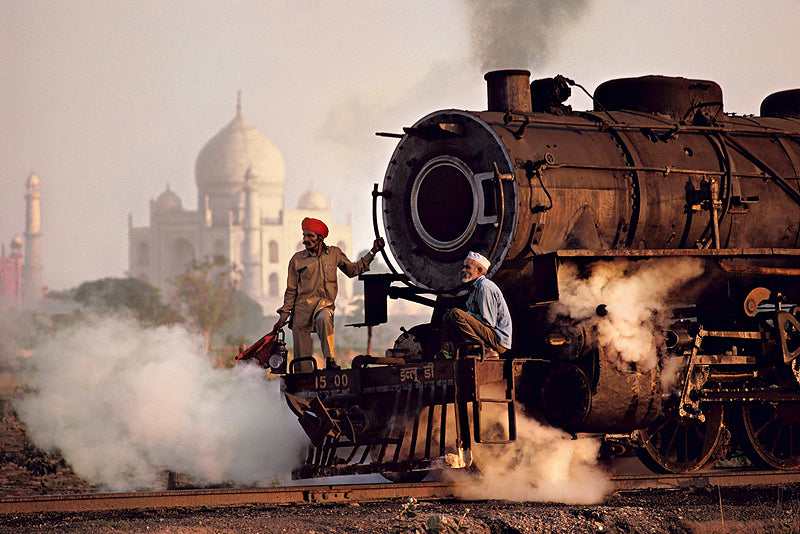As we focus on some of the best photographers in the industry and in their particular genres, it is with some difficulty that we focus on a photographer who has done so much to add to collection of images and shape the way we think about images from around the world as Steve McCurry (www.stevemccurry.com). I was given his book Portraits (1999) as a Christmas gift one year, and I have thumbed through this book innumerable times. I would even take the book to places where I knew I would have an hour or so when I was supposed to be listening to a speaker, and I would lose myself in the images of people, their softness reflected by the film by which they were taken, adding to the depth. They were rich in color, and so many seemed to be suspended in time. I remember thinking of these images on the first day that I wandered an international city, wondering what I was doing. I was in Iquitos, Peru, and came away that day with three or four images of people that surprised me. For me, Steve McCurry represents the experience of a seasoned photographer, and an example of someone continuing to shape the photographic world.
STEVE'S BACKGROUND
Steve McCurry was born in 1950 in Philadelphia and studied at Penn State, studying filmmaking and film history. There, he graduated cum laude from the College of Arts of Architecture. There he worked on the newspaper as a photographer and continued after college, working several years at a newspaper and then heading off to India to work as a freelancer during some years that seemed to have formed what would come in his career.
STARTING IN INDIA
Steve McCurry makes no secret that the beginning of his international photographic career began in India where he freelanced. The attraction, he mentions, was the diversity of the people, the young and old, the rich and the poor. India, and its daily life, appeared to McCurry as "intense" in comparison to the United States. One classic example that Steve notes on his blog was his close call at a beach in Bombay at the festival Ganesh Charturthi:
"My camera and all of my equipment were destroyed in this incident. I was photographing this amazing event on the last evening of the festival about twenty minutes after sunset, illuminating the scene with my flash and standing in chest-deep water. Suddenly, out of nowhere, a group of drunken revelers came over and started pounding me, grabbed m camera which was around my neck and pulled the camera and my head under water. I stopped worrying about my camera, and started thinking about the possibility of drowning. My assistant [. . .] was also thrown under the water and beaten up. Eventually, one man came to my rescue and helped escort me back to the beach. I felt lucky to be alive at that point."
NOTABLE MOMENTS
Steve McCurry is probably best known for his photograph of the Afghan woman, featured on a 1985 cover of National Geographic. This image is considered by some to be one of the most recognized photographs in the world. In 2002, Steve returned to the area to find the woman, Sharbat Gula, with a team from National Geographic. They succeeded, and McCurry stated that "her skin is weathered; there are wrinkles now, but she is a striking as she was all those years ago." After shooting film for thirty years (his collection of transparencies is around 800,000), he switched to digital capture, noting the special advancements and conveniences such as changing ISO values on every shot, coupled with improved high ISO sensitivity and functioning. Kodak bestowed on him the special privilege of shooting the last roll of Kodachrome slide film produced by the company. These images from this last roll reside in the George Eastman House in Rochester, New York.
GETTING THE SHOT
McCurry is quick to note that he is drawn mainly to the "human aspect" of a picture, connecting with the subject somehow. In addition to this, the aesthetics of the image play a large part of the image, especially the composition. He seems to understand that the complexity of the image where the color, composition, and the story all come together to create a final presentation. McCurry has noted multiple times that early in his career, the people in the areas in which he was photographing treated him mainly as a curiosity, and therefore, he developed a method of getting the shot before the people noticed him or he would be around long enough that they didn't seem to care anymore. He has mentioned that in the past some of his best shots - including some of the most fun he has had - were captured during days where he would simply wander the streets, letting situations and their subsequent images show themselves. Interestingly, he feels that most of his time out searching for images may not be productive, but if even a couple of shots come to fruition during the day, his time is well spent.
STEVE'S EQUIPMENT
Steve has been using Nikon equipment such as the D700 and a Hasselblad Medium format camera. For his printing nowadays, he uses an Epson printer and is considered an Epson Pro. He has mentioned that his favorite printer has been an Epson large format printer.
MCCURRY'S BOOKS
McCurry has published books including The Imperial Way (1985), Monsoon (1996), Portraits (1999), South Southeast (2000), Sanctuary: The Temple of Angkor (2002), The Path to Buddha: A Tibetan Pilgrimage (2003), Phaidon 55: Steve McCurry (2005), Looking East (2006), and In the Shadow of the Mountains (2007), Unguarded Moment (2009), The Iconic Photographs (2011)
Stay connected to Steve: Website | Blog | Facebook
RELATED ARTICLES
Focus on Photographers - Tom Till
How Do You Know When You Are Good? Canon Explorers of Light Answer
VII Photo Agency's Stephen Mayes Discusses Photojournalism







